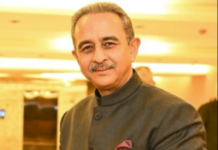NEW DELHI — Each winter, Delhi disappears under a suffocating gray blanket of smog. Clear October skies quickly turn opaque, headlines brand it the world’s pollution capital, schools shut down, and the familiar finger-pointing begins — often with Diwali firecrackers taking the blame. Yet according to Akhilesh Mishra, CEO of BlueKraft Digital Foundation, this annual outrage masks deeper and more persistent causes. His data-based analysis shows that Delhi’s pollution stems not from festival fireworks but from chronic structural failures — most notably road dust, vehicular emissions, biomass burning, diesel generators, and seasonal farm fires.
Mishra identifies road dust as Delhi’s largest polluter. Unpaved roads, broken pavements, and piles of construction material create vast dust reservoirs stirred up continuously by vehicles. Scientific studies show that dust alone contributes about 40 percent of Delhi’s particulate pollution — nearly twice that of vehicular emissions. If authorities ensured proper paving, greenery, and maintenance of roadsides, Mishra argues, the city could dramatically cut particulate matter within a year. Cleaner streets would not only improve air quality but also restore dignity to public spaces, benefiting pedestrians, commuters, and street vendors.
Despite Delhi’s massive number of vehicles, Mishra’s findings show they play a secondary role compared to dust and external smoke. While policies promoting electric vehicles and phasing out old cars remain vital, targeting tailpipes alone cannot solve a problem dominated by dust and combustion beyond the roads.
Across Delhi’s poorer neighborhoods, many families burn wood, trash, or crop residue for warmth or cooking when clean fuel is unaffordable. These small fires collectively release vast amounts of fine particulate matter, especially dangerous during winter nights when temperature inversions trap pollutants near the ground. Mishra calls for empathetic governance — providing affordable heating, cleaner energy, and better waste management instead of relying solely on punitive measures.
Diesel generators, commonly used even with stable electricity supply, emit toxic fumes directly at breathing level. According to Mishra, solar rooftops, battery storage, and cleaner backup power options already exist — but implementation lags due to weak enforcement and lack of urgency.
Every autumn, smoke from crop residue burning in Punjab, Haryana, and western Uttar Pradesh drifts into Delhi, contributing up to 50 percent of its air pollution during a few critical weeks. Mishra stresses that known solutions — such as machinery subsidies, residue buy-back, and inter-state coordination — must be enforced consistently, particularly in Punjab, to end these seasonal “smog tsunamis.”
Diwali fireworks do raise short-term pollution levels, but Mishra’s analysis shows that these spikes dissipate within a day. The sustained haze that follows comes from structural sources — dust, stubble smoke, and biomass burning. He notes that Delhi’s air began deteriorating sharply only after 2014, following a legal change in Punjab’s paddy cycle that delayed stubble clearing and concentrated smoke emissions in late fall.
Mishra’s conclusion is blunt: Delhi’s smog is a governance failure, not a natural fate. He proposes a realistic, phased plan — one year to eliminate road dust through paving and mechanized sweeping, two years to end crop burning through machinery and enforcement, and three years to phase out diesel gensets and biomass burning with affordable clean energy. “Delhi’s pollution is man-made — and so is the solution,” Mishra emphasizes. What the city needs, he says, is not symbolic outrage or festival bans but sustained, accountable governance that confronts the real sources of its toxic air. (Source: IANS)













